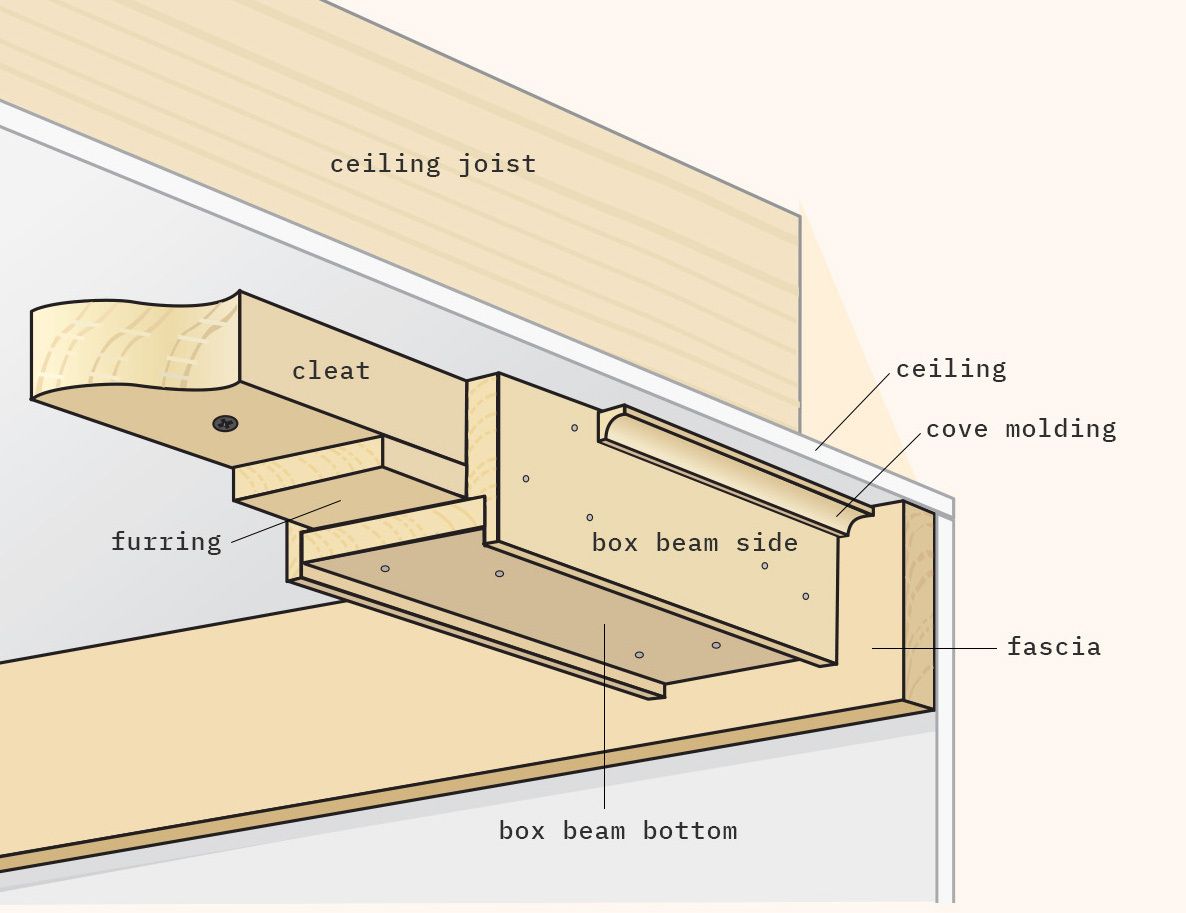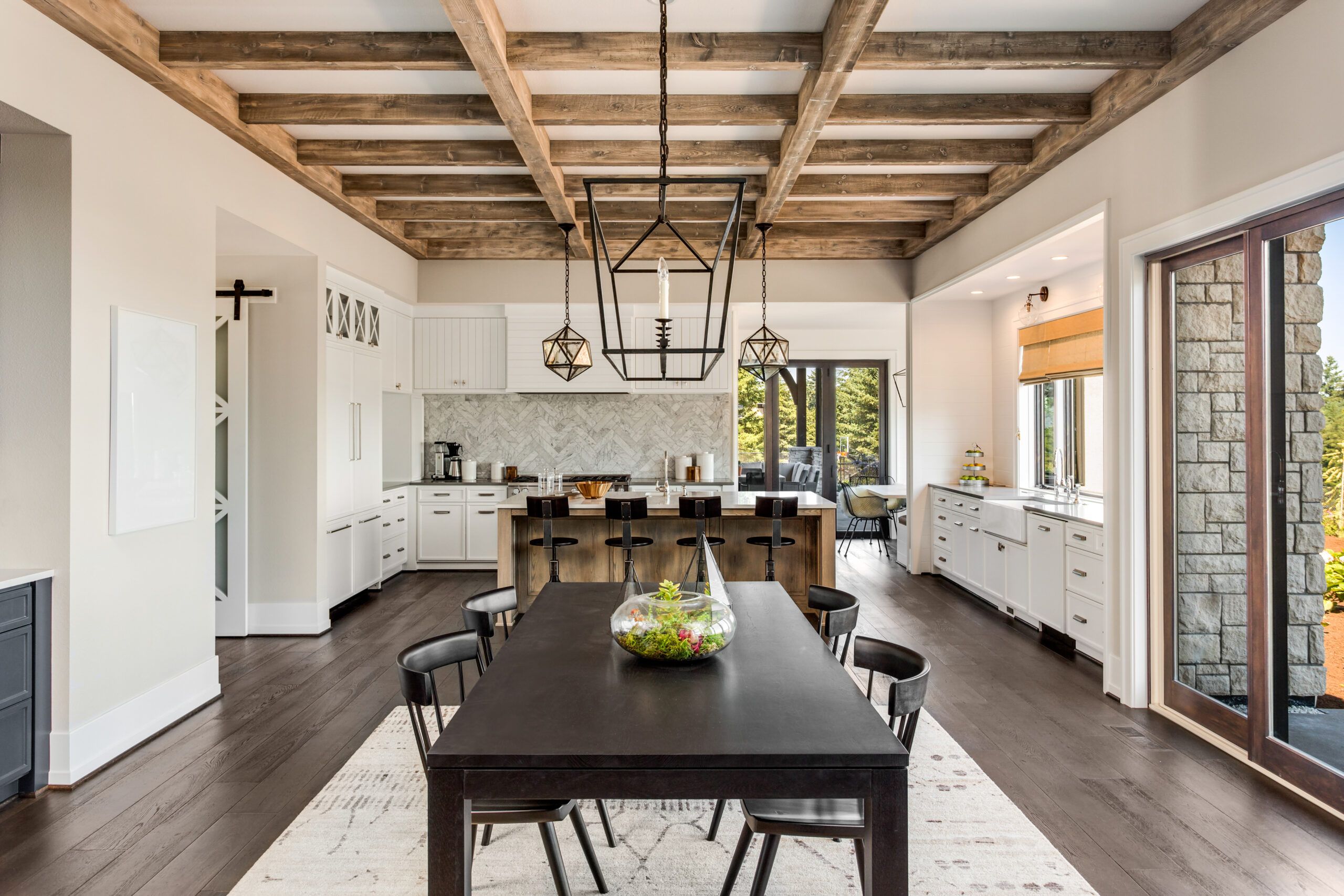Transforming your ceiling with decorative wood beams can add elegance and warmth to your home. Our guide will walk you through the process of installing a wood beam ceiling. This project is best suited for intermediate to advanced do-it-yourself (DIY) enthusiasts with basic carpentry skills.
Planning Your Wood Beam Ceiling
Plan meticulously before starting the installation process to ensure a visually appealing result and structurally sound beams.
Determining Beam Placement
First, sketch a layout of your ceiling and plan where the beams will go. Consider symmetry and how the beams will interact with existing light fixtures, ceiling fans, and other features. Beams typically run perpendicular to the joists for added support.
Measuring and Choosing Wood Beam Materials
Measure the dimensions of your ceiling and mark the beam placement. Calculate the number of beams you need and the type of wood that suits your design. Common materials include pine, oak, and cedar. You may choose between solid wood beams or faux beams, which are often made from polyurethane foam and are lighter and easier to handle.
Gathering Your Tools and Materials
Having the right tools and materials on hand can help you have a smooth, efficient project. Here’s a list of items you’ll need:
- Measuring tape
- Chalk line
- Stud finder
- Screwdriver
- Drill
- Saw
- Wood screws
- L-brackets
- Wood stain or paint (optional)
Wood Beam Ceiling Installation Steps

Follow the detailed steps below to install your wood beam ceiling:
Step 1: Locate Ceiling Joists
Using a stud finder, locate the ceiling joists and mark them with a pencil or chalk line. Joists will serve as anchor points to stabilize the beams.
Step 2: Cut the Wood Beams
Based on your measurements, cut the beams to fit your ceiling layout. Make sure each cut is precise to avoid gaps between beams. If you’re using faux beams, a handsaw or circular saw will work. For solid wood beams, we recommend a miter saw or table saw.
Step 3: Secure Mounting Brackets or Dimension Lumber Nailer
Attach L-brackets to the ceiling joists at your marked locations using wood screws. These brackets will hold the beams in place. Check that the brackets are level and securely fastened.
You can also install dimension lumber nailers. If you plan to have a frieze—a board that runs along the wall at the ceiling intersection—end the nailers far enough away from the wall that you’ll be able to slip the frieze into place. If your beams will run the short dimension of the room, that’s likely the same direction as the ceiling joists. Let the layout of the ceiling joists dictate the layout of your beams.
Step 4: Install the Wood Beams
The sides of ceiling beams are usually made from 1×3, 1×4, or 1×6, depending on the depth you want. You can use primed lumber or hardwood. If using hardwood, stain and finish it before installation. If the beam is to be painted, apply one finish coat before installation. The bottom material can be solid wood or plywood since the sides will hide the edges.
You can make the bottoms of the beams two ways. Some people like to have the sides hang down, leaving a 1/4 inch or so reveal below the bottom, while others want the bottom and the sides flush. Hanging down is a little easier, but it all comes down to preference.
- If you want the sides to hang below the bottom, cut furring strips to attach to the bottom of the nailer. Say you are using 1×4 sides and a 1×4 bottom, and you want a 1/4 inch reveal. The combined depth of the nailer (1 ½ inches), bottom piece (3/4 inch), and reveal (1/4 inch) equals 2 ½ inches. The 1×4 measures 3 ½ inches, so the furring will need to be 1 inch thick. Make sure the strips are narrower than the nailer by a ¼ inch or so, and nail them to the 2-by nailer on the ceiling.
- Install the frieze if there is one, then cut the sides and bottom to length. Fasten one side to the nailer with 2-inch finish nails.
- Spread wood glue on one edge of the bottom, and with a helper to hold it in place, nail it to the installed side, again with 2-inch finish nails. If the bottom of the beam is to be flush, make sure you nail as close to that as you can.
- Once the glue dries, you’ll need to clean up any discrepancies with a sander. If there’s to be a reveal, hold the bottom tight to the furring on the nailer, but don’t nail it there until after you’ve nailed the sides to the bottom.
- Spread glue on the other edge of the bottom, hold the other side in place, and nail it to the bottom as well. You might need to clamp it here and there to get a tight joint.
- Wipe off any glue before it dries.
Step 5: Finishing Touches
Once all beams are installed, inspect the ceiling for gaps or unevenness. Fill small gaps with wood filler and sand the area smooth. You could also use trim strips, which can be simple 3/4-inch lattice or cove molding. If desired, apply wood stain or paint to match your interior décor.
Addressing Common Wood Beam Ceiling Challenges
Even with careful planning, challenges may arise during your wood beam installation. Here are solutions to some common issues:
Uneven Ceilings
Ceilings that aren’t perfectly level can cause gaps between beams and the ceiling surface. Shim the beams with thin strips of wood to achieve a snug fit.
Heavy Beams
Solid wood beams can be heavy and difficult to maneuver. Consider using faux beams made from lightweight materials for easier handling.
Structural Integrity
Confirm that your ceiling joists can support the additional weight of the beams. Consult with a structural engineer if you have concerns about ceiling load capacity.
Wood Beam Ceiling Design Ideas and Inspirations
Decorative wood beams can suit various home styles. Here’s some decor inspiration to help you choose the perfect beam design for your space:
Rustic Charm
For a rustic look, choose beams with a distressed finish. Visible knots and grain patterns can add character and warmth to your room.
Modern Elegance
To complement a modern interior, opt for sleek, clean-lined beams in a dark stain or stark white. The contrast of beams against a light-colored ceiling can make a dramatic statement.
Coastal Vibes
Whitewashed beams evoke a breezy, coastal feel. Pair them with light-colored walls and beach-inspired décor for a serene atmosphere.
Traditional Appeal
Dark, richly stained wood beams complement traditional homes with classic furnishings. Incorporate architectural details such as coffered ceilings for added sophistication.
Maintenance and Care for a Wood Beam Ceiling
You don’t need much upkeep to maintain your wood beam ceiling. Here’s what we recommend.
Cleaning
Dust the beams regularly using a soft cloth or a vacuum with a brush attachment. For deeper cleaning, use a mild wood cleaner and a soft sponge. Avoid using too much water, as it can damage the wood.
Inspections
Periodically inspect the beams for signs of damage or wear. Check for cracks, warping, or pest infestations. Early detection of issues allows for timely repairs and maintenance.
Staining and Sealing
If your beams are stained or painted, consider reapplying the finish every few years to maintain their appearance. Sealing the wood can protect against moisture and extend the beams’ lifespan.
Wood Beam Installation Safety Considerations
Safety should always be a priority when undertaking a DIY project. Here are some essential safety tips to follow.
Personal Protective Equipment (PPE)
To protect yourself from sawdust, debris, and sharp tools, wear appropriate PPE, such as safety goggles, work gloves, and a dust mask.
Ladder Safety
Use a sturdy, stable ladder when working on the ceiling. Ensure it’s positioned on a flat surface, and never overreach while on the ladder.
Heavy Materials
When handling heavy beams, use proper lifting techniques to avoid injury. If possible, enlist the help of a friend or family member to assist with lifting and positioning the beams.
Electrical Awareness
Be cautious of any electrical wiring or fixtures in the ceiling. To prevent electrical accidents, turn off the room’s power before drilling or cutting into the ceiling.
Cost Considerations for Wood Beam Ceilings
The cost of installing a wood beam ceiling depends on several factors, including the type of wood, the size of the room, and whether you use solid or faux beams. You may also need to pay for hardware and tools if you don’t already own what you need for this project. According to Angi, wood beam installation can cost as little as $225 or as much as $10,300.
Our Conclusion
Installing a wood beam ceiling is a rewarding DIY project that can dramatically enhance the look and feel of your home. With careful planning, the right materials, and attention to detail, you can achieve a stunning result that showcases your style and craftsmanship. Remember to prioritize safety throughout the process and consult with professionals if needed.

